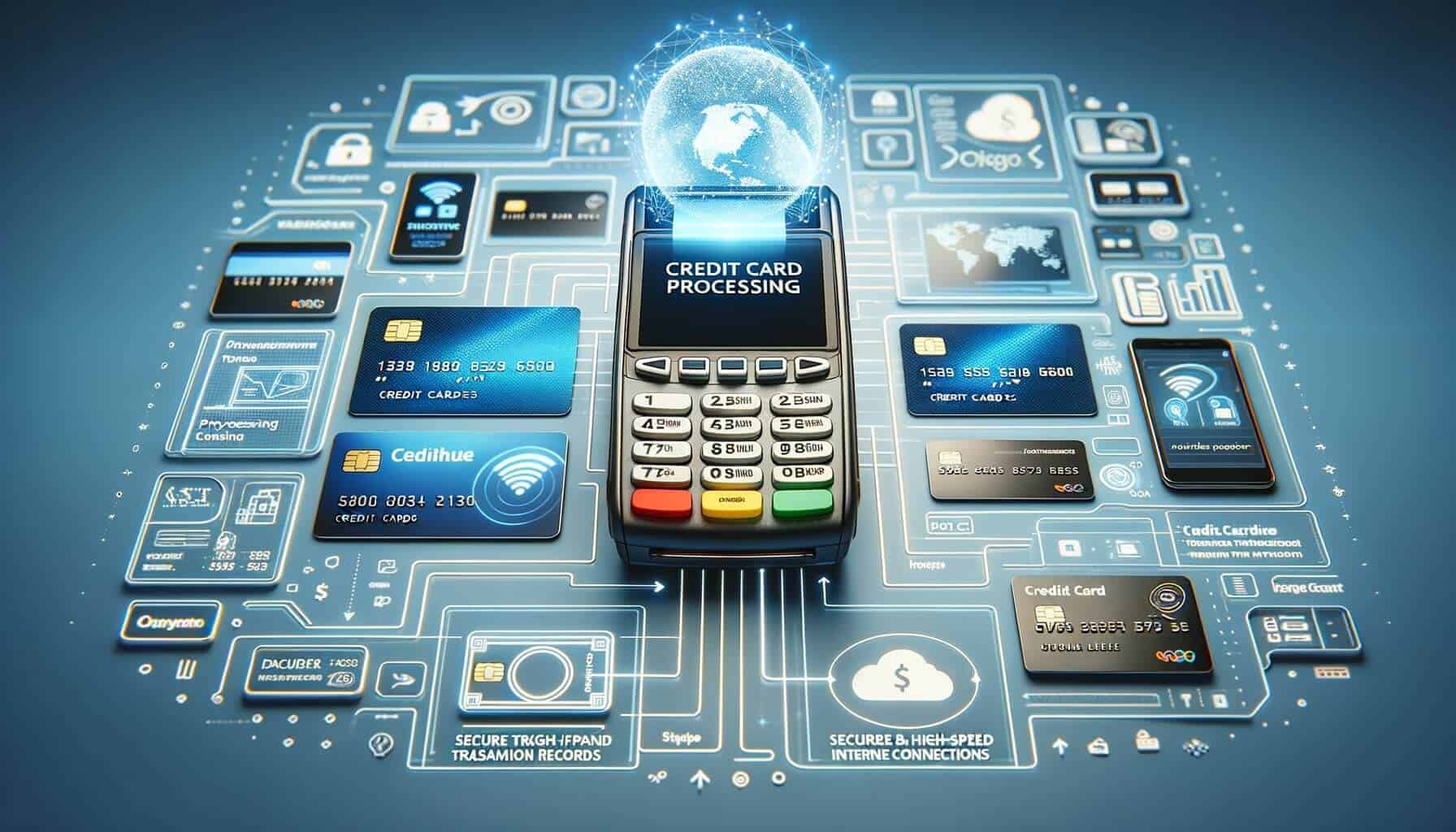
By Catharine Proctor January 29, 2025
In today’s digital age, credit card processing has become an essential part of running a business. Whether you operate a brick-and-mortar store or an online e-commerce platform, accepting credit card payments is crucial for attracting customers and increasing sales. One of the most convenient and efficient ways to process credit card payments is through a virtual terminal.
A credit card processing virtual terminal is a web-based application that allows businesses to accept credit card payments without the need for physical card readers or terminals. It provides a secure and convenient way to process payments, making it an ideal solution for businesses of all sizes.
How Does a Credit Card Processing Virtual Terminal Work?

A credit card processing virtual terminal works by converting credit card information into a digital format that can be securely transmitted over the internet. When a customer makes a purchase, the merchant enters the customer’s credit card information into the virtual terminal, which then sends the information to the payment processor for authorization.
The payment processor verifies the customer’s credit card details and checks if the customer has sufficient funds to complete the transaction. If the transaction is approved, the payment processor sends a confirmation message back to the virtual terminal, and the merchant can proceed with the sale. The entire process takes just a few seconds, allowing for quick and seamless transactions.
Benefits of Using a Credit Card Processing Virtual Terminal

There are several benefits to using a credit card processing virtual terminal for your business. Firstly, it eliminates the need for physical card readers or terminals, saving you the cost of purchasing and maintaining these devices. This is particularly advantageous for small businesses or startups with limited budgets.
Secondly, a virtual terminal allows you to accept credit card payments from anywhere with an internet connection. Whether you’re in your office, at a trade show, or on the go, you can easily process payments using your laptop, tablet, or smartphone. This flexibility enables you to provide a seamless payment experience to your customers, regardless of your location.
Another benefit of using a virtual terminal is the ability to accept payments from multiple payment methods. In addition to credit cards, many virtual terminals also support debit cards, e-checks, and even mobile wallet payments. This versatility ensures that you can cater to a wide range of customer preferences and increase your chances of making a sale.
Setting Up a Credit Card Processing Virtual Terminal: Step-by-Step Guide

Setting up a credit card processing virtual terminal is a relatively straightforward process. Here is a step-by-step guide to help you get started:
Step 1: Choose a Virtual Terminal Provider
The first step is to choose a virtual terminal provider that suits your business needs. Look for a provider that offers competitive pricing, robust security features, and excellent customer support. Consider factors such as transaction fees, monthly fees, and contract terms before making a decision.
Step 2: Sign Up for an Account
Once you’ve selected a provider, sign up for an account on their website. You will need to provide some basic information about your business, such as your company name, address, and contact details. Some providers may also require additional documentation, such as proof of identity or business registration.
Step 3: Set Up Payment Gateway Integration
After signing up, you will need to integrate your virtual terminal with a payment gateway. A payment gateway is a service that securely transmits credit card information between the virtual terminal and the payment processor. Your virtual terminal provider will guide you through the integration process, which typically involves entering your payment gateway credentials.
Step 4: Configure Payment Settings
Once the integration is complete, you can configure your payment settings. This includes specifying the types of payment methods you want to accept, setting up tax and shipping options, and customizing your receipt templates. Take the time to review and adjust these settings to ensure they align with your business requirements.
Step 5: Test the Virtual Terminal
Before going live, it’s essential to test your virtual terminal to ensure everything is functioning correctly. Process a few test transactions using different payment methods to verify that the payments are being processed accurately and that the receipts are generated correctly. This step will help you identify and resolve any issues before accepting real payments.
Step 6: Go Live
Once you’re satisfied with the testing phase, you can start accepting real payments through your virtual terminal. Promote your new payment method to your customers and provide clear instructions on how to use it. Monitor your transactions and payment reports regularly to ensure smooth operations and address any issues promptly.
Understanding the Security Features of a Credit Card Processing Virtual Terminal
Security is a top concern when it comes to credit card processing, and virtual terminals are no exception. To protect sensitive customer data and prevent fraud, virtual terminals incorporate various security features. Here are some key security features to look for when choosing a virtual terminal provider:
1. PCI Compliance: The Payment Card Industry Data Security Standard (PCI DSS) is a set of security standards that all businesses accepting credit card payments must adhere to. Ensure that your virtual terminal provider is PCI compliant and follows the necessary security protocols to protect cardholder data.
2. Encryption: Look for a virtual terminal that uses encryption technology to secure credit card information during transmission. Encryption ensures that the data is scrambled and can only be decrypted by authorized parties, making it virtually impossible for hackers to intercept and misuse the data.
3. Tokenization: Tokenization is a process that replaces sensitive credit card data with a unique identifier called a token. The token is used for transaction processing, while the actual card data is securely stored in the virtual terminal provider’s system. This adds an extra layer of security by reducing the risk of data breaches.
4. Fraud Detection and Prevention: A robust virtual terminal should have built-in fraud detection and prevention mechanisms. These may include address verification services (AVS), card verification value (CVV) checks, and velocity filters that flag suspicious transactions or patterns. These features help minimize the risk of fraudulent activities and protect both merchants and customers.
Integrating a Credit Card Processing Virtual Terminal with Your E-commerce Platform
If you operate an e-commerce platform, integrating your credit card processing virtual terminal with your website is essential for a seamless payment experience. Here are some steps to guide you through the integration process:
1. Choose an E-commerce Platform
Firstly, choose an e-commerce platform that supports virtual terminal integration. Popular platforms such as Shopify, WooCommerce, and Magento often have built-in integrations or plugins that make the process easier. Consider factors such as pricing, features, and customization options when selecting a platform.
2. Install the Virtual Terminal Plugin or App
Once you’ve chosen an e-commerce platform, install the virtual terminal plugin or app provided by your virtual terminal provider. This plugin will enable the integration between your virtual terminal and your e-commerce platform, allowing for seamless payment processing.
3. Configure the Integration Settings
After installing the plugin, configure the integration settings according to your business requirements. This may include entering your virtual terminal credentials, specifying the payment methods you want to accept, and customizing the appearance of the payment form to match your website’s design.
4. Test the Integration
Before making the integration live, conduct thorough testing to ensure that the virtual terminal is working correctly on your e-commerce platform. Test various scenarios, such as different payment methods, shipping options, and order quantities, to ensure that the integration is seamless and error-free.
5. Go Live
Once you’re satisfied with the testing phase, make the integration live on your e-commerce platform. Update your website’s payment options to include the virtual terminal, and inform your customers about the new payment method. Monitor the integration closely in the initial days to address any issues promptly.
Choosing the Right Credit Card Processing Virtual Terminal Provider
Choosing the right credit card processing virtual terminal provider is crucial for the success of your business. Here are some factors to consider when selecting a provider:
1. Pricing Structure: Compare the pricing structures of different virtual terminal providers to find one that aligns with your budget. Look for providers that offer transparent pricing with no hidden fees. Consider factors such as transaction fees, monthly fees, setup fees, and any additional charges for features or integrations.
2. Security Features: Ensure that the virtual terminal provider prioritizes security and offers robust security features. Look for features such as PCI compliance, encryption, tokenization, and fraud detection mechanisms. A secure virtual terminal will protect your customers’ data and minimize the risk of fraud.
3. Payment Methods Supported: Consider the payment methods supported by the virtual terminal provider. Ideally, you should choose a provider that supports a wide range of payment methods, including credit cards, debit cards, e-checks, and mobile wallet payments. This ensures that you can cater to diverse customer preferences and increase your sales potential.
4. Integration Options: If you have an e-commerce platform or plan to integrate the virtual terminal with other software systems, ensure that the provider offers seamless integration options. Look for plugins, APIs, or pre-built integrations with popular e-commerce platforms and other software solutions relevant to your business.
5. Customer Support: Good customer support is essential when dealing with any technology solution. Look for a virtual terminal provider that offers reliable customer support through multiple channels, such as phone, email, and live chat. Prompt and knowledgeable support can help resolve any issues quickly and minimize disruptions to your business.
FAQs
Q1. What is the difference between a physical card reader and a virtual terminal?
A physical card reader is a device that connects to a computer or mobile device and allows you to swipe or insert credit cards for payment processing. A virtual terminal, on the other hand, is a web-based application that enables you to manually enter credit card information into a secure online portal.
Q2. Can I use a virtual terminal for in-person transactions?
While virtual terminals are primarily designed for remote transactions, some providers offer solutions that allow you to use a virtual terminal for in-person transactions. These solutions typically involve using a card reader connected to a computer or mobile device.
Q3. Is it safe to enter credit card information into a virtual terminal?
Yes, it is safe to enter credit card information into a virtual terminal if the provider follows proper security protocols. Look for providers that are PCI compliant, use encryption technology, and offer additional security features such as tokenization and fraud detection mechanisms.
Q4. Can I accept payments from international customers using a virtual terminal?
Yes, most virtual terminal providers support international payments. However, you may need to check with the provider to ensure that they support the specific payment methods and currencies required for international transactions.
Q5. Can I use a virtual terminal on my mobile device?
Yes, many virtual terminal providers offer mobile apps or mobile-optimized websites that allow you to process payments on your smartphone or tablet. This provides flexibility and convenience, especially for businesses that operate on the go or at events.
Conclusion
A credit card processing virtual terminal is a powerful tool that enables businesses to accept credit card payments securely and conveniently. It eliminates the need for physical card readers, allowing businesses to process payments from anywhere with an internet connection. By following the step-by-step guide to setting up a virtual terminal, businesses can quickly integrate this payment solution into their operations.
The security features of a virtual terminal, such as PCI compliance, encryption, and tokenization, ensure that customer data is protected and minimize the risk of fraud. Integrating a virtual terminal with an e-commerce platform further enhances the payment experience for online customers.
When choosing a virtual terminal provider, businesses should consider factors such as pricing, security features, supported payment methods, integration options, and customer support. By selecting the right provider, businesses can streamline their payment processes and provide a seamless experience to their customers.
In conclusion, a credit card processing virtual terminal is a valuable tool for businesses looking to enhance their payment capabilities and improve customer satisfaction. By leveraging the benefits of a virtual terminal and choosing the right provider, businesses can stay ahead in today’s competitive marketplace.